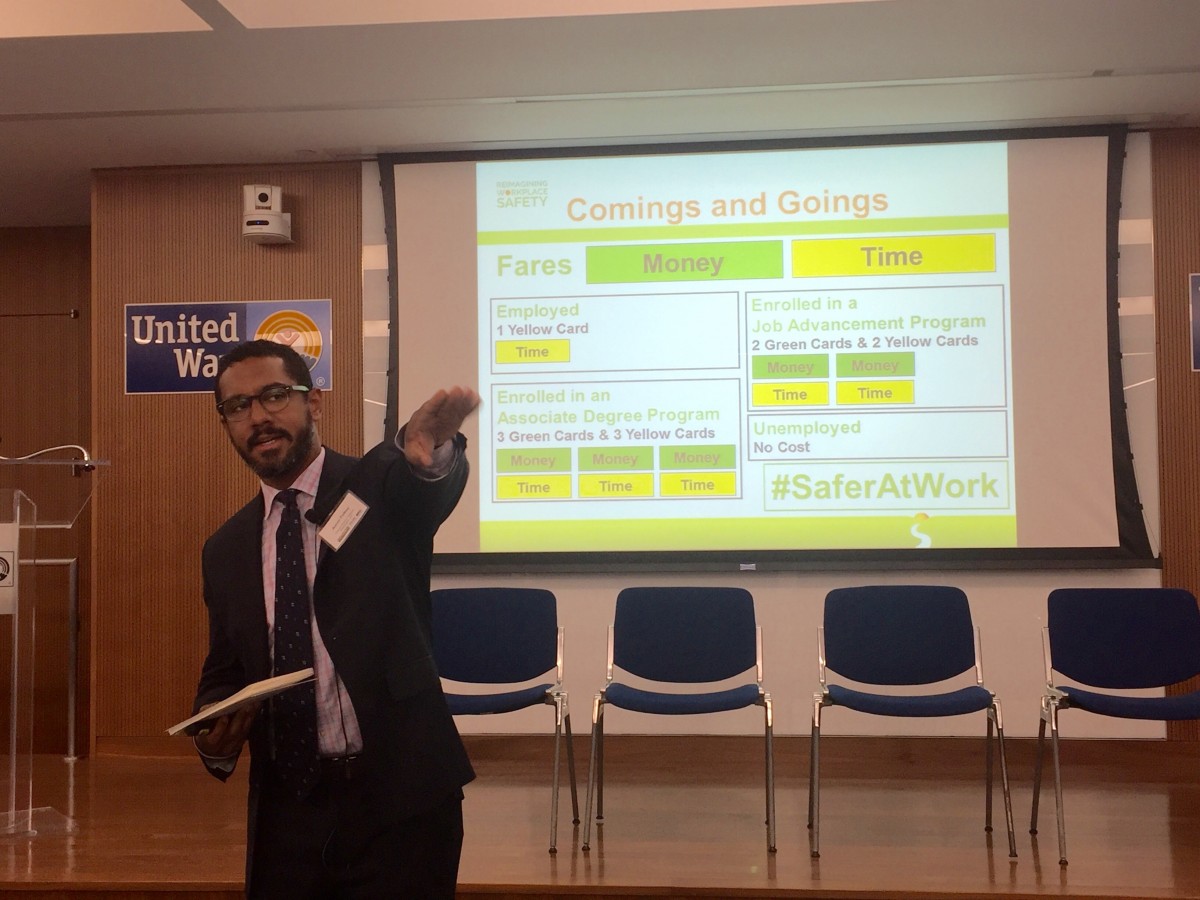Tackling Workplace Violence: A Recap of our #SaferAtWork Convening

“You are an unmarried 28-year-old woman with one child, age 5. You and your daughter previously lived with your former partner, who is your daughter’s father, but you recently moved out and got your own place because of incidents of physical abuse. Your highest level of education attained is a high school diploma. Your job experience is primarily in the hospitality and janitorial industries, and you are currently employed at a hotel as a hotel room cleaner. The hotel is not unionized, but has the potential for union engagement.”
My voice quavered as I read those words aloud and asked more than 70 union leaders and workers’ rights advocates who attended Reimagining Workplace Safety to assume the role of a vulnerable woman worker. I knew that I was about to read unsettling descriptions of violence and exploitation arising from and affecting the workplace. And the expressions on the participants’ faces showed that they were already starting to empathize with the lack of options available to women who have no choice but to work for low wages and are particularly vulnerable to domestic violence, sexual violence, sexual harassment, and stalking both at the workplace and at home.
Futures Without Violence, United Way Worldwide, and the Department of Justice’s Office on Violence Against Women found it crucial to first focus directly on the challenges of the women we seek to help before we could start exploring how union leaders, workers’ right advocates, health and safety experts, researchers, advocates against sexual and domestic violence, and advocates for gender, race, and economic justice can work together to organize and uplift vulnerable women workers. To bring those challenges into focus, I was given the task of facilitating our opening “Comings and Goings” exercise, where attendees were asked to assume the role of a vulnerable woman worker and walk through her impossible choices.
Would she attempt to enrich herself through a job advancement or associate degree program despite the challenges of limited resources and excessive costs, such as tuition, transportation, child care, and obtaining proof of citizenship? Could she tolerate remaining at a job where both her supervisor and customers sexually harass her and get away with it due to her lack of empowerment and recourse? Or would such exploitation force her to return to her abusive partner, where she and her young child fear for their safety and well-being?
Keeping her at the forefront of our minds, we spent the rest of the day developing solutions to make the workplace, where we spend most of our waking hours, a refuge of safety and empowerment for workers vulnerable to violence and exploitation.
 Leaders from SEIU-USWW (West), Equal Rights Advocates, and the Maintenance Cooperation Trust Fund shared their methods to galvanize support for janitorial workers in California. Women who work in isolated worksites, or late at night, are particularly susceptible to workplace sexual violence, and benefit from targeted strategies that led to such victories as California’s passage of legislation requiring more transparency in the janitorial industry.
Leaders from SEIU-USWW (West), Equal Rights Advocates, and the Maintenance Cooperation Trust Fund shared their methods to galvanize support for janitorial workers in California. Women who work in isolated worksites, or late at night, are particularly susceptible to workplace sexual violence, and benefit from targeted strategies that led to such victories as California’s passage of legislation requiring more transparency in the janitorial industry.
Linda Seabrook, FUTURES’ General Counsel, facilitated a panel featuring leaders in our Low Wage, High Risk Pilot Site Project. Panelists representing the Coalition of Immokalee Workers and the Restaurant Opportunities Center (ROC) demonstrated through their successes how high road employers and consumers are central to efforts to use the workplace as a vehicle to free women from violence. Engaging all stakeholders on the full range of the personal costs of producing and delivering the food, products, and services we all consume has sparked notable industry-led partnerships.
 Labor leaders then examined the role that race and gender play in issues of sexual violence and economic justice and declared that all work going forward to lift up vulnerable women workers should have a gender or racial lens.
Labor leaders then examined the role that race and gender play in issues of sexual violence and economic justice and declared that all work going forward to lift up vulnerable women workers should have a gender or racial lens.
After learning more about the power of current research and data and refining communications strategies to deliver the message to wider audiences, we ended the day developing new collaborative organizing strategies, innovative research and regulatory ideas, and creative promising practices.
But our minds lingered on the 28-year-old hotel room cleaner and her predicament. And since I was among the less than ten men in the room, my mind lingered on the need for more men, especially those who are union leaders and members, to experience the “Comings and Goings” exercise and spend some time walking in the shoes of vulnerable women workers.
After all, violence against women is not just a women’s issue. It can affect everyone’s safety at the workplace, as well as severely impact the health, safety, and economic standing of entire families. We must address these issues together.
To learn more about Reimaging Workplace Safety, visit our Storify at http://ow.ly/mFNe304A0h8




